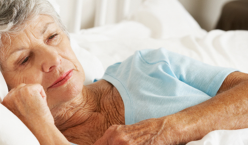Attorney for Bed Sores Stages
Nursing Home Abuse & Neglect
Pennsylvania | New Jersey Injury Lawyer
Bedsores · Wrongful Death · Malpractice Lawsuits · Elder Abuse

Bucks County wrongful death attorney and nursing home abuse and neglect lawyer, Brian P. Murphy, handles all stages of bed sores cases
Stages of Bed Sores
Bed sores, also known as pressure sores or decubitus ulcers, are an injury to the surface areas and underlying tissues of the skin. There are several bed sores stages, which are detailed below.
Stage I Bed Sores
When referring to bed sores stages, a Stage I bed sore is the initial stage of development when the body is subjected to prolonged exposure to pressure. Stage I bed sores develop on bony prominences of the body where there is less muscle and tissue between the skin and the underlying bone. The sores often develop on heels, elbows, hips, shoulder blades, and on the sacrum area of the buttocks. The continuous pressure wears down the skin and forms a wound. In addition to pressure, other factors that can also contribute to the development of a Stage I bed sore include malnutrition, dehydration and poor hygiene.
A Stage I bed sore appears as a reddened area on the skin, usually about the size of a coin but can be larger or smaller at times. Depending upon adjacent tissue, the sore can be either warm or cool to the touch. Some individuals may experience minor pain and itching at the site of the sore. At Stage I, the skin is not yet broken, as the sores have not impacted the underlying tissues and muscle. If caught early, Stage I bed sores are fairly easy to heal.
Stage II Bed Sores
When bed sores reach Stage II, these wounds develop when the body is continuously subjected to prolonged exposure to pressure. On the surface, the skin abrasion appears like a blister, commonly pinkish or red in color and shallow in depth. If left untreated, the sore will either form a painful ulcer, break open, or wear away the skin. During this earlier stage of wound development, the sore can be healed fairly easily if the nursing staff acts quickly and effectively.
Stage II bed sores are a sign of a worsening wound. Once the bed sore reaches Stage II, the injury has expanded deeper, and the skin has broken. The outer layer of skin (epidermis) and part of the underlying layer of skin (dermis) are damaged or lost. This creates an open wound that, if not properly treated, leaves underlying tissues, muscle, and bone vulnerable.
Stage III Bed Sores
A Stage III bedsore is a severe wound that is categorized by the medical community as a medical error that should not happen. At this point in the bed sores stages, the skin’s injury extends even deeper into the underlying tissue, as a small crater begins to form that creates visibility of fat within the sore.
At this stage, the bed sore has deteriorated in significant ways. The wound’s depth has increased significantly, and the tissue within the bed sore is necrotic (has begun to rot). This leads to full loss of subcutaneous tissue, the tissue immediately under the skin, which exposes fat below the tissue. Stage III bedsores often begin to exude a strong odor and can be very painful. They are often accompanied by infection, which can be very problematic for the individuals’ health. The extensive tissue damage that occurs during the third stage of bed sore development makes the wound significantly harder to heal and very vulnerable to further deterioration.
Stage IV Bed Sores
Stage IV bedsores are very severe wounds that are also recognized by the medical community as a medical error that should not occur. At this stage, the bed sore shows large-scale loss of tissue and appears as a large hole with considerable depth. The necrosis (rotting of tissue) has expanded, and the bed sore may now expose muscle, bone, or tendons. The bottom of the bed sore likely contains dead tissue that appears yellowish or dark in color. The muscle and tissue damage often expands beyond the primary wound below layers of healthy skin.
Stage IV bed sores are extremely painful to the touch, as the injury has now extended deeper into the tissue. Reaching the bone and muscle at this point, the sore has potentially damaged the tendons and joints. Without aggressive and continuous care and treatment, a Stage IV bed sore will deteriorate into a gaping wound that tunnels down to the underlying bone. Stage IV bed sores can quickly become infected and develop into a life-threatening condition.
Unstageable Bed Sores
An Unstageable bed sore is a pressure ulcer that has full thickness tissue loss (Stage III or IV) but is covered with decaying tissue and the true depth of the wound cannot be determined until after the necrotic tissue is cleared and the base of the wound is visible.
Deep Tissue Injury
Deep tissue injuries are purple or maroon areas of intact skin or blood-filled blisters caused by damage to underlying soft tissue. Beneath the skin, the tissue is rotting due to prolonged pressure and eventually the skin opens up, exposing the depth of the wound.
Experience Matters
If your loved one has developed a wound that falls under any of these bed sores stages, you should contact bed sore attorney Brian P. Murphy. In PA and NJ, Brian has been handling nursing home bed sore cases and other types of nursing home abuse and neglect since 2006. He is fully familiar with nursing home neglect that leads to the development and deterioration of bed sores. Mr. Murphy understands the legal obligations of the area’s nursing homes (especially Bucks County, Montgomery County, and Philadelphia, as well as all of Pennsylvania and New Jersey). These facilities need to make certain that bed sores do not occur and, if they do, they need to quickly and effectively address them. Listed below are examples of duties that PA and NJ nursing homes owe to their residents in preventing bedsores.
- Nursing home staff must timely and effectively assess residents for their propensity to develop bed sores. If they do not and a bed sore develops, the nursing home is responsible for the development of the bed sore.
- Should a resident be at risk of developing a bed sore, the nursing home staff then has the responsibility to create a care plan with interventions meant to prevent the development of bed sores. Interventions typically include turning and repositioning the resident, keeping the resident clean, hydrated, and nourished. If this does not happen, the Pennsylvania or New Jersey nursing home can be held liable.
- When an intervention is placed in a care plan, the intervention must be implemented timely and continuously by the nursing staff. If this does not happen, the facility can be held liable.
- PA and NJ nursing homes (including Philadelphia, Bucks, and Montgomery counties) are required to inform a resident’s family members immediately upon the development of a bed sore. If this does not happen the nursing home can be held responsible.
Contact Nursing Home Attorney Brian Murphy

This website is owned by Attorney Brian P. Murphy. Its purpose is to assist you in understanding your rights, especially when it comes to preventing or protecting yourself and/or your loved ones against nursing home abuse, neglect, bedsores, dehydration, and wrongful death. Legal matters are billed on a contingency fee basis.
Nothing on this website is to be construed as attorney advice or otherwise creating an attorney-client relationship. If you may be interested in establishing a relationship with The Law Firm of Brian P. Murphy, PC, please contact us to discuss your options.
